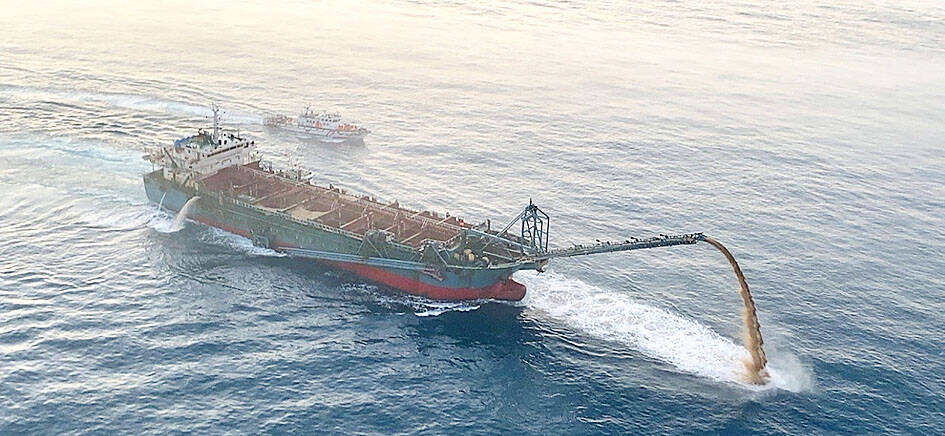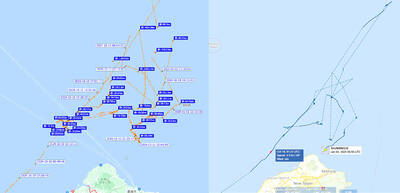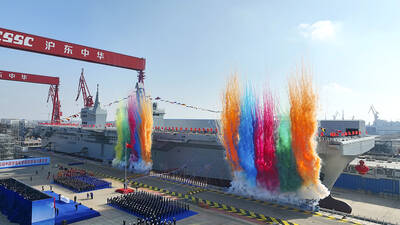Taiwanese officials and academics on Wednesday urged Southeast Asian nations to initiate joint legal action against China, citing environmental and economic havoc wreaked by sand dredging operations enabled by Beijing.
The international community should make use of strategic, legal and environmental means to tackle China’s illegal dredging, which has a serious negative effect on the region, Ocean Affairs Council Minister Kuan Bi-ling (管碧玲) told an international conference on dredging in Taipei.
The International Conference on the Impact of Sand Dredging on the Sea was a collaboration between the council and National Taiwan Ocean University. It was attended by academics from Japan, Malaysia, the Philippines and the US.

Photo courtesy of the Coast Guard via CNA
In 2013, Beijing begin digging up sand and building artificial islands with a fleet of dredgers near the Paracel Islands (Xisha Islands, 西沙群島), causing massive environmental damage, said Gregory Poling, director of the Southeast Asia Program and the Asia Maritime Transparency Initiative at the US-based Center for Strategic and International Studies.
These activities are part of Beijing’s strategy of utilizing its coast guard and artificial islands to deny access to the South China Sea to those that dispute China’s claims, Poling said.
China banned dredging in its territorial waters while simultaneously subsidizing civilian vessels to engage in the same behavior under the protection of the Chinese Coast Guard, which severely harms the legal rights of other nations, he said.
The privilege of a nation-state to exploit resources within its economic maritime zone does not absolve that nation of its responsibility to protect the ocean environment, said Tsai Chi-ting (蔡季廷), an associate professor of political science at National Taiwan University.
Although international maritime law does not specifically regulate sand dredging, the discriminatory nature of Chinese dredging runs contrary to the responsible management of ocean resources required by the laws and conventions within the industry, Tsai said.
Beijing should acknowledge that its dredging operations are an obvious breach of international law and desist, he said.
China has been excavating sand from the seabed near Lienchiang County since 2018, when Beijing declared that Taiwanese waters could be utilized for sand dredging to support China’s construction sector, the National Academy of Marine Research wrote in a news release.
A recent sonar survey found holes from dredging — including some that are up to 5m deep and cover nearly 600m2 — over 40 percent of the seabed off the Matsu islands, it said, adding that dredging has clearly altered the natural topography.
Seabed zones that showed signs of dredging supported a significantly lower density of planktonic plants and fish larvae, which indicated that the activity caused ecological damage, it said.
China’s dredgers have removed enough sand from the waters off Taiwan to severely degrade the ocean environment, said Jeng Ming-shiou (鄭明修), a marine biologist and Academia Sinica researcher.
Dredging could change the structure of the seabed sand layer, which would have devastating ecological repercussions, he said.
Sand from the sea is widely regarded as a strategic resource and dredging is a global industry that generated US$60 billion in 2018, said Rima Prama Artha, lead economist at Indonesia’s Danareksa Research Institute.
Sand dredging is contributing to the loss of 24 Indonesian islands and could harm the livelihoods of 35,000 fishers in the country, she said.
Taiwan should act in concert with other democratic nations to handle China’s illegal dredging, as the nation’s lack of UN membership would complicate its efforts to seek redress through legal means, said Makoto Seta, associate professor of international law at Japan’s Waseda University.
Additional reporting by Hung Ting-hung

A strong continental cold air mass and abundant moisture bringing snow to mountains 3,000m and higher over the past few days are a reminder that more than 60 years ago Taiwan had an outdoor ski resort that gradually disappeared in part due to climate change. On Oct. 24, 2021, the National Development Council posted a series of photographs on Facebook recounting the days when Taiwan had a ski resort on Hehuanshan (合歡山) in Nantou County. More than 60 years ago, when developing a branch of the Central Cross-Island Highway, the government discovered that Hehuanshan, with an elevation of more than 3,100m,

Taiwan’s population last year shrank further and births continued to decline to a yearly low, the Ministry of the Interior announced today. The ministry published the 2024 population demographics statistics, highlighting record lows in births and bringing attention to Taiwan’s aging population. The nation’s population last year stood at 23,400,220, a decrease of 20,222 individuals compared to 2023. Last year, there were 134,856 births, representing a crude birth rate of 5.76 per 1,000 people, a slight decline from 2023’s 135,571 births and 5.81 crude birth rate. This decrease of 715 births resulted in a new record low per the ministry’s data. Since 2016, which saw

SECURITY: To protect the nation’s Internet cables, the navy should use buoys marking waters within 50m of them as a restricted zone, a former navy squadron commander said A Chinese cargo ship repeatedly intruded into Taiwan’s contiguous and sovereign waters for three months before allegedly damaging an undersea Internet cable off Kaohsiung, a Liberty Times (sister paper of the Taipei Times) investigation revealed. Using publicly available information, the Liberty Times was able to reconstruct the Shunxing-39’s movements near Taiwan since Double Ten National Day last year. Taiwanese officials did not respond to the freighter’s intrusions until Friday last week, when the ship, registered in Cameroon and Tanzania, turned off its automatic identification system shortly before damage was inflicted to a key cable linking Taiwan to the rest of

China’s newest Type-076 amphibious assault ship has two strengths and weaknesses, wrote a Taiwanese defense expert, adding that further observations of its capabilities are warranted. Jiang Hsin-biao (江炘杓), an assistant researcher at the National Defense and Security Research, made the comments in a report recently published by the institute about the Chinese Communist Party’s (CCP) military and political development. China christened its new assault ship Sichuan in a ceremony on Dec. 27 last year at Shanghai’s Hudong Shipyard, China’s Xinhua news agency reported. “The vessel, described as the world’s largest amphibious assault ship by the [US think tank] Center for Strategic and International